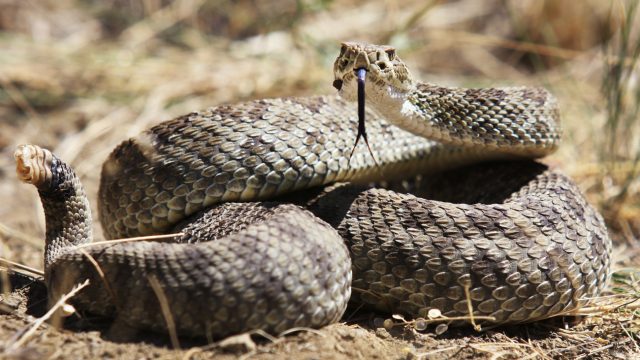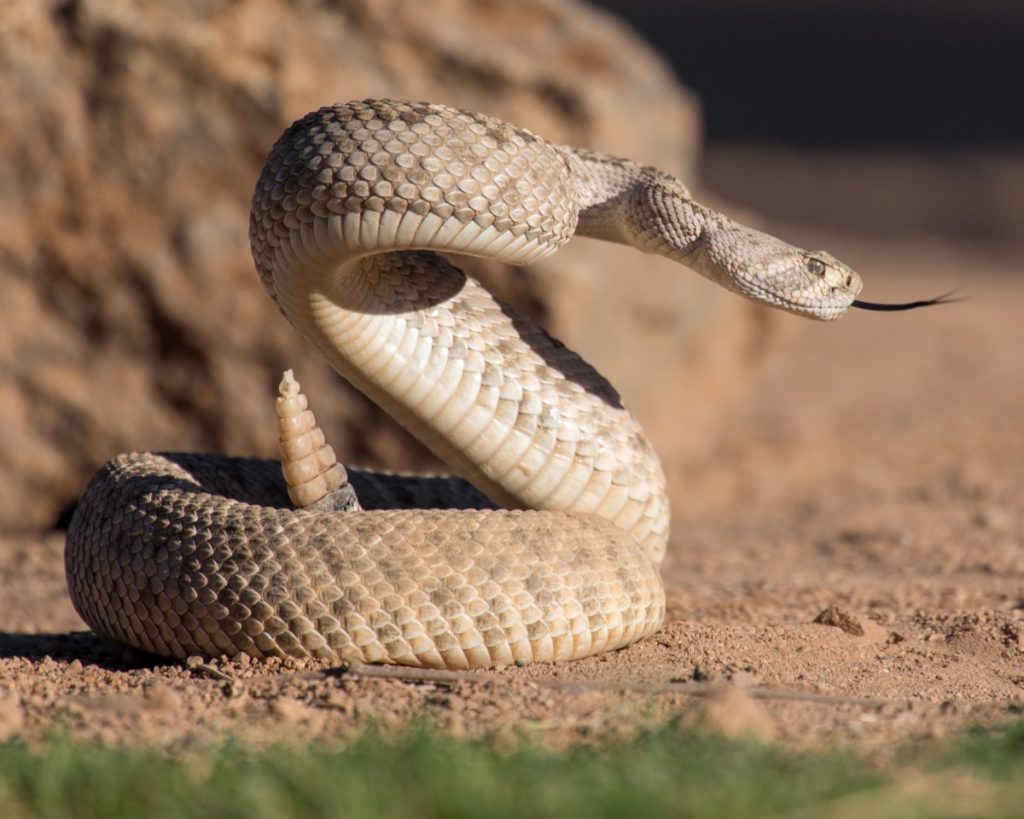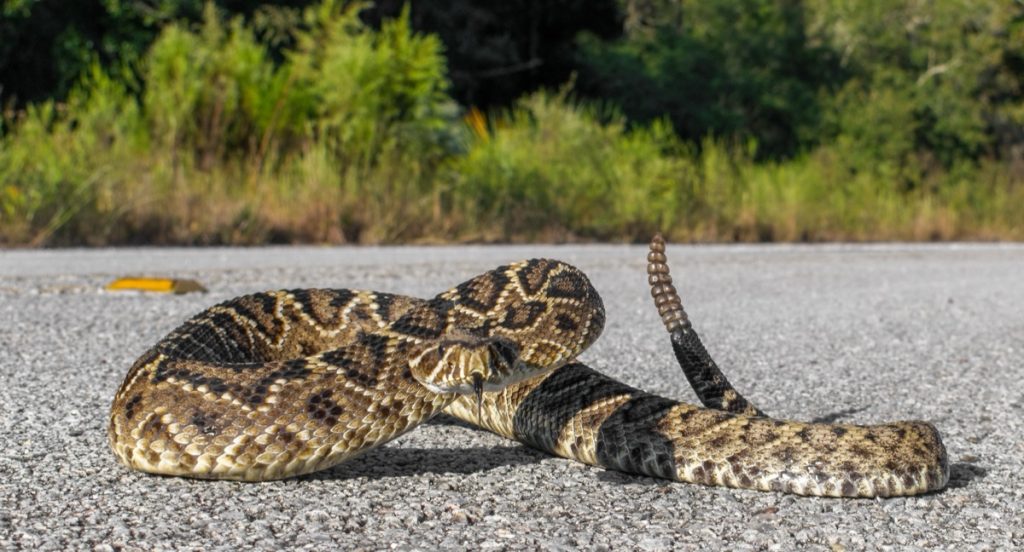Rattlesnake Bites Reported Across the U.S.—Here’s Where They’re Striking

The possibility of getting bitten by a rattlesnake is one of the many risks that come with spending time outdoors. And while it’s possible to take extra care to avoid the venomous reptiles and stay prepared for any run-ins, accidents that unfortunately result in some rather serious medical emergencies can still happen. Now, a wave of rattlesnake bites has been reported across the U.S.—including in some surprising and unexpected settings. Read on to see where they struck and how to keep yourself safe.
READ THIS NEXT: 4 Scents That Attract Snakes to Your Yard, Experts Say.
There were recently two boys bitten by rattlesnakes in separate incidents in California.

Warmer weather can make it easier to get outdoors and enjoy nature, but it can also make you more likely to run into a venomous snake. Unfortunately, a pair of recent incidents in California shows just how true that can be.
On June 7, a seven-year-old boy was running along a trail in Mt. Diablo State Park in the afternoon when he suddenly felt a sharp pain in his lower leg, CBS News reports. While he never saw the snake that bit him, the boy’s mother carried him to a parking lot, where he was then airlifted to a hospital by helicopter. Doctors determined his symptoms were consistent with those seen with rattlesnake bites and were able to treat him.
Unfortunately, it wasn’t the last time someone in the area would suffer a similar emergency. On July 16, a 13-year-old boy was also bitten by a rattlesnake in a rural area of Calistoga, CBS News reported. While it’s unclear exactly where the incident occurred, local authorities had the young victim airlifted by helicopter to a nearby hospital, where he was treated with antivenom.
“As we know, there are a lot of rattlesnakes that live in this area, especially in this time of year and after all the rain we’ve had. The rattlesnakes are out in abundance,” Contra Costa Fire Battalion Chief Ross Macumber said in a statement after the June 7 incident. “So anybody who is walking or hiking in this area really needs to be cautious. Don’t step over logs, don’t step over rocks. Always look in those places for potential rattlesnakes.”
Another rattlesnake bite victim in Virginia was flown to the hospital.

A separate incident that required quick medical action also took place on the East Coast. On July 15, the Big Island Volunteer Fire Company received a call that someone in the area of Camp Doom in Rockbridge County, Virginia, had suffered a snakebite and required assistance, local FOX affiliate WFXR reported.
Four fire departments responded to the call—including one with swift boats to navigate the river—before the victim was located. They were then taken by ambulance to an area where a helicopter picked them up and airlifted them to a nearby hospital for treatment. According to the Boonsboro Volunteer Fire & Rescue Company, the animal responsible for the bite was later confirmed to be a rattlesnake, WFXR reported.
RELATED: For more up-to-date information, sign up for our daily newsletter.
A fourth victim was bitten in a fairly surprising place.

It’s not uncommonto see a rattlesnake on the hiking trail, but it’s certainly something of a shocker to come across one while you’re taking a dip.
On July 9, nine-year-old Tasia Noyes was on a boat with her family in the Ririe Reservoir in Bonneville County, Idaho. But it wasn’t until the family took a quick break from wakeboarding to jump in the water and cool off for a minute that things took a turn.
“When I was ready to get out, I just tried to climb back up on the ladder, and I felt a sting in my knee, so I swam away. I looked where the ladder was, and then I saw a snake, and I like… yelped!” Noyes told EastIdahoNews.com.
Her brother says he noticed a small snake swimming in the water, which he flicked away from the boat with a stick. Her father then saw a bite mark on Tasia’s right knee and decided to rush her to the hospital for treatment, where she was given antivenom.
“We didn’t know exactly what kind of snake bite it was, but they looked at it and could see that it was already discoloring,” Danielle Noyes, the victim’s mother, told EastIdahoNews.com. “Tasia had symptoms like throwing up. They also ran her blood work. They could tell it was in the rattlesnake family.”
Officials involved with the incidents warn the public to stay vigilant for rattlesnakes.

Fortunately, Tasia responded well to her treatment thanks to her family’s quick response time, which got her medical attention within just 35 minutes of the incident.
“We were so grateful that we were able to access medication so quickly. The staff at [the hospital] was fantastic and so kind. We expect she will make a full recovery,” her mother told the news outlet.
And while she says she’d still consider going back for a swim, Danielle says she’ll be extra cautious from now on—and knows exactly what to do if anything goes wrong. “When you think of a rattlesnake, you think of it coiled on a trail. You don’t think about it swimming under the water,” she said. “If it happens to you, just be aware that there are venomous snakes here in Idaho…and if you get bit, seek treatment as quickly as possible.”
Experts say that besides getting medical attention, there are a few other important safety tips to keep in mind if you’re ever bitten.
“Do not try any interventions like tourniquets or cutting and sucking to get the venom out,” Eric Day, director of EMS services at Eastern Idaho Regional Medical Center where Noyes was treated, told EastIdahoNews.com. “Additionally, if you can take a picture of the snake, it will help ensure that you get the correct antivenom.”
You can also avoid run-ins by sticking to usual trails and avoiding any tall grass or underbrush where snakes will typically hide during the day, according to the U.S. Forest Service. It’s also best to step up onto any rocks or fallen trees instead of over them, as a snake may be hidden on the other side.